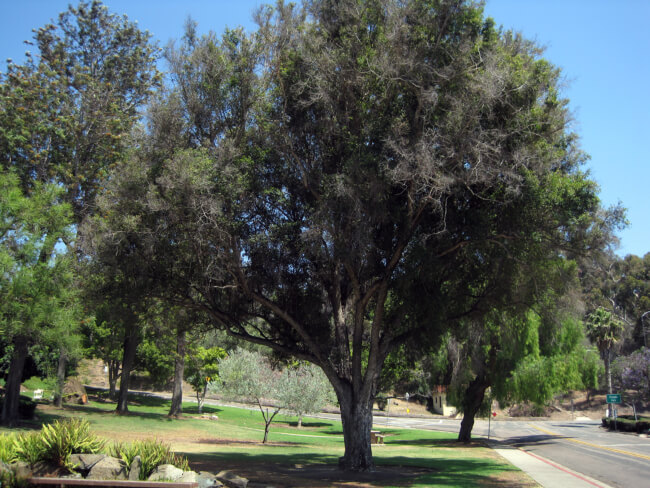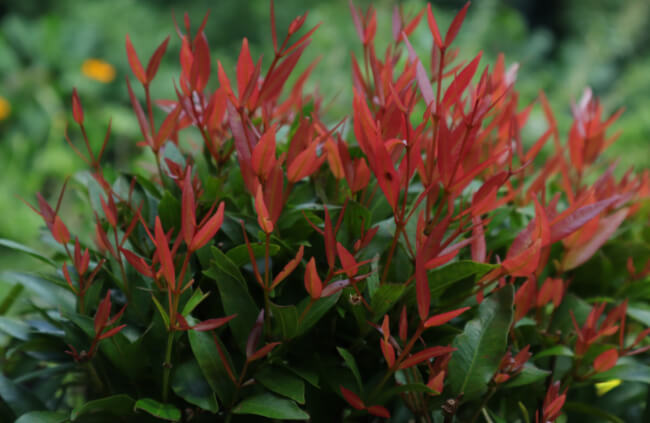Characterised by its broad, dense and bushy growth, Syzygium paniculatum is a spectacular native rainforest tree that features attractive tapered foliage, glossy leaves, clusters of fluffy white flowers in spring and highly decorative fruits to boot.
A notorious bush tucker species, this tree’s showy fruits are edible and are identified by their glossy pinkish colours and variable uses in the kitchen.
I’ve always been a huge admirer of the Syzygium genus (also known as Acmena or Eugenia) so I am excited to share my knowledge of this showy species with you in this article.
More...
Family: | Myrtaceae |
|---|---|
Genus: | Syzygium |
Species: | S. paniculatum |
Common Names: | Magenta Lilly Pilly, Neighbours Be Gone, Backyard Bliss |
Origin: | Australian Native |
Location: | Outdoor |
Type: | Tree or shrub |
Growth: | 3 to 15 metres tall, 2 to 10 metres wide |
Sun requirements: | Full sun to part shade |
Foliage Colour: | Green |
Flower Colour: | White |
Flowering: | Spring |
Edible Parts: | Produces edible pinkish fruits after flowering |
Maintenance level: | Low |
Poisonous for pets: | Non-toxic to cats and dogs |
Getting to Know Syzygium paniculatum

Source: PlantMaster
Further elevating this tree’s exquisite displays within gardens, it also produces flushes of reddish-pink new growth that can decorate outdoor spaces for most of the year.
It offers many useful landscaping applications in gardens using its dense growth, evergreen foliage and attractive canopy. Enjoy one of the most cultivated Syzygium species throughout Australia with S. paniculatum.
Read on to find out how you can grow and care for this beautiful tree in your landscape.
Magenta Lilly Pilly Plant Details
Botanically labelled Syzygium paniculatum, the tree’s common names include magenta cherry, magenta lilly pilly or less commonly, brush cherry. Part of the Myrtaceae family like many of its relatives, the tree is native to coastal New South Wales.
This species prefers warmer regions so its preferred climates are subtropical, warm temperate and Mediterranean.
Considered fast-growing, magenta cherry can reach around 3 to 15 metres tall and 2 to 10 metres wide. However, cultivated in gardens, it typically only reaches about 10 metres tall and 5 metres wide, perfect for larger or smaller spaces.
This particular species is very similar to another popular relative in the genus, Syzygium australe. The glossy fruits and nectar-rich flowers will attract a variety of birds, bees and butterflies.
Common Landscaping Applications for Brush Cherry
The tree’s attractive canopy lends to rainforest-themed gardens and shady gardens but overall, this is a very variable rainforest tree.
Common uses include:
- Feature specimen
- Topiary
- Hedging and screening
- Windbreak
- Gap filling
How to Grow Syzygium paniculatum
You can grow Syzygium paniculatum by planting the entire fruit or just the seed, but you can also grow it using cuttings. The tree responds well to pruning which is great to maintain a specific shape and also to encourage more lush growth. Pruning also creates an abundance of flowers and fruit.


Get Your Free Guide:
Master Growing Australian Natives eBook
A Must Have Complete Guide for Every Australian Garden
Get Your Free Guide:
Master Growing Australian Natives eBook
A Must Have Complete Guide for Every Australian Garden
Backyard Bliss, another popular name for Syzygium paniculatum, grows quickly and maintains a good looking appearance throughout the year as a hedge or screen for your garden to allow for privacy. It’s not just drought tolerant but can also handle frost once it has established itself.

Source: Save Our Heritage Organisation
Propagating Syzygium paniculatum
You can propagate your own Syzygium paniculatum from semi-hardwood cuttings, using a section of new growth at the end of the branches that is already quite firm. The ideal time for taking cuttings is after summer and anytime thereafter from autumn into spring.
Aim for cuttings to be a length between 8 and 10 cm. When you make the cut, do it below a group of leaves. Once you have your cuttings, you can remove the leaves at the base of the stem and leave around 3 at the top of the stem.
Your growing mixture needs to be well-draining and allow for air pockets. You could use a mixture of 75% sand and 25% coconut coir, or an equal mix of sand, coco coir, and perlite. Once you’ve filled your planting containers, you can water the mixture to create moist soil for planting.
Dip the end of each cutting into a rooting hormone before placing in the mixture. The cuttings should be placed somewhere warm and not in direct sun. Mist them each day to maintain moist soil but it should never be waterlogged.
Once germination has taken place and roots formed, you can then ideally transplant your Magenta Lilly Pilly from the end of summer into autumn. The warm soil at this seasonal stage helps to promote root development. It also means you won’t need to water your Syzygium paniculatum as often.
Best Growing Conditions for Syzygium paniculatum
Once established, this species is hardy and tolerant to a variety of growing conditions. However, it will certainly thrive and look its best in more ideal situations. It is good to keep in mind that this tree needs sufficient room to grow once established so be sure to choose your planting site accordingly.

Lighting Needs
Full sun to part shade is preferred for this tree to fruit and flower more prolifically. The more full sun it gets, the more vivid its display will be and the better it will look overall. It can tolerate half shade but try to give it at least 6 hours of full sun each day.
Ideal Soil Conditions for Magenta Lilly Pilly
While the tree can tolerate different types of soil, it does tend to prefer loam-based soil in gardens. The soil must be well-drained and retain moderate moisture levels in-between waterings.
It would be ideal to enrich your soil with some compost and other organic materials before planting.
Growing Magenta Cherry in Containers
Magenta cherries can be successfully grown in large containers. Certain varieties can even be bonsaied. The tree will naturally grow smaller in containers and it will still require adequate light and care. It is recommended to use a quality potting mix for containers.
Caring for Syzygium paniculatum
Like many of its relatives in the genus, Syzygium paniculatum is a hardy and mostly fuss-free addition to the garden, especially once established. Once matured, the tree will be tolerant to only light frosts but it will be drought tolerant.
If you choose to grow this species in cooler regions, I would recommend growing it in a larger container so that you can overwinter the plant indoors during the harsher winter conditions.
As with many ornamental plants, magenta lilly pilly will also grow its best with basic regular care.
Watering Needs
Water regularly until established. Extra supplemental water is beneficial during the hottest months of the year. In the height of summer, the tree will require deep watering about 2 to 3 times per week depending on how fast your soil dries out. Water less in winter.
Pruning Brush Cherry
Prune regularly to encourage your desired shape and to keep the foliage dense and compact. Pruning in early spring will encourage more prolific flowers and fruits. Unpruned specimens can get leggy with gaps in the foliage.
Mulching
Keep the tree well mulched during its development and the warmer active growing seasons. Organic mulch is preferable for bush tuckers.
Fertilising Syzygium paniculatum
Fertilise your tree a few times throughout the year to encourage faster growth and the production of quality fruits and flowers. Organic fertilisers are always preferred for any bush food.
Fallen Fruits
Fallen fruits can pose a slipping and tripping hazard. Be sure to try and plant the tree further enough away from any structures like paths, buildings, roads and so on. After fruiting, a good clean-up around the plant is always beneficial for aesthetics and safety.
Magenta Lilly Pilly Bush Tucker Guide

This is a well-known species for producing edible wild fruits. The small cherry-like fruits are said to have a pleasantly sour apple-like flavour profile, which naturally has many culinary uses in both sweet and savoury applications.
The fruits can vary in colour while they develop. Fruits can be magenta pink, purple and even white, further elevating this tree’s spectacular displays throughout the flowering and fruiting periods.
The fruits are globe or cherry shaped and about 25 mm long and wide.
Benefits of Magenta Cherry
This fruit is considered a super food and has plenty of health benefits including being good for your skin, increasing collagen and protecting against UV rays. They are packed with plenty of vitamin C, fruit acids, folate, and calcium, making the fruit anti-aging and anti-inflammatory.
Indigenous Australians called Syzygium paniculatum fruit “medicine berries” as they were used to treat infections and colds.
How to Harvest and Use Magenta Lilly Pilly Berries
- Berries will ripen between summer and autumn when they will turn from a pale pink to a deeper cherry-red colour. They will also feel plump and firm when ready.
- Once ready, simply pluck ripe fruits from the branches as needed.
- Be sure to rinse them before consumption or storage.
- These berries can be eaten fresh or cooked.
- Fresh berries are tartier so many prefer cooking, baking or boiling them.
- The fruits are most commonly cooked into jams, jellies, sauces, marinades and much more.
Storing Brush Cherry Berries
The fruits will keep in the fridge for up to 3 weeks and in the freezer for up to 2 years. Conditions can affect these durations.
Syzygium paniculatum Pests and Diseases
Lilly Pilly Psyllid
This insect likes to burrow in the leaves of Syzygium paniculatum, creating pimple looking damage that is unsightly. They suck the sap from your plant and you might notice that its growth starts to look distorted.
Scale
Scale is another sap sucking pest that feasts on the leaves and stems of your plant. In the case of a small infestation, you can try and remove the scale by scraping them off with your nails.
In more severe cases, you can use a petroleum-based spray like white oil which actually suffocates the scale. This same treatment can be used against psyllids.
Myrtle Rust
Symptoms of Myrtle Rust include spots on the leaves that are brown or grey and sometimes have a reddish ring around them. After a number of days, you’ll probably see plenty of yellow and orange powdery spores on top of the leaf spots.
You’ll need to get rid of any leaves that are damaged, and follow up with sulphur dust as a weekly treatment. Neem oil is also a great organic fungicide and pesticide that can be used for treatment.Syzygium paniculatum Frequently Asked Questions

What is Syzygium paniculatum used for?
This highly ornamental rainforest tree is commonly used as a feature or topiary specimen in smaller landscapes as it features brilliant red new growth, glossy green leaves, fluffy cream-white blooms and edible pinkish-red fruits.
In larger spaces, Syzygium paniculatum can be used for hedging and screening or gap-filling.
Is Syzygium paniculatum fast-growing?
Yes, this vigorous species is considered fast-growing, usually growing about 1 metre or more per year in good conditions.
How quickly do Syzygium paniculatum grow?
When the tree has established itself, it can grow at least 2 metres per year. The younger years when the tree is still settling its roots sees a slower growth which then speeds up as the tree reaches maturity.
Sunlight also plays a role here. If Syzygium paniculatum is planted in full sun it will grow more quickly and bigger in size than the same plant grown in part shade.
What spacing should I use when planting Backyard Bliss?
For those wanting to create a thick hedge, you can space each plant 40 cm apart or aim to include 5 plants per metre. If you are planting Backyard Bliss close to a fence or wall, aim for a gap of at least 60 cm.
Can you eat magenta cherry fruits?
Yes, the cherry-like fruits are edible both fresh and cooked. They turn ripe after flowering in autumn once they become fleshy, and firm and turn from a pale pinkish-white to a deeper magenta-pink.
Use them to enhance your favourite jams, jellies, sauces, marinades and much more.
How do you care for Syzygium paniculatum?
Plant the tree in a spot that gets full sun to part shade in well-draining enriched soil. Water, prune, mulch and fertilise regularly until established.
Why is my brush cherry dying?
Species in the Syzygium genus do not tolerate waterlogged soil well. Overwatering or poorly drained soil can lead to the roots sitting in waterlogged soil which can eventually kill the tree.
Be sure to only water once the soil is dry and use well-drained soil.
What is the difference between Syzygium paniculatum and Syzygium australe?
Both are popular picks in the genus but Syzygium australe is a more common species that can reach up to 20 metres tall whereas S. paniculatum is rarer and only grows to a height of about 10 to 15 metres tall.
See our in-depth guide on Syzygium Australe for more details. Also, check out more varieties in our main lilly pilly article.
Aside from Backyard Bliss, what are other great privacy creating plants in Australia?
Viburnum tinus makes a great hedge and grows up to four metres in height. It is also evergreen. Pittosporum tenuifolium is another popular evergreen choice native to Australia. They can reach a height up to five metres and have an oval shape.
Callistemon are known for being hardy and these Australian natives are low maintenance and can reach up to 10 metres high.
In need of more gardening inspiration and advice? Sign up for our newsletter.
Add Some Native Spectacle and Style to Your Garden with Syzygium Paniculatum
I hope I’ve managed to convey just how much there is to love about this spectacular native rainforest species, Syzygium paniculatum. Whether for its form, all-round decorative features, or its bush food, this tree certainly has a lot to offer both growers and gardens.
Enjoy vivid displays, dense canopied foliage, and a useful bush tucker with our prolifically bountiful Syzygium paniculatum tree.
Published on October 11, 2023 by Lorri Hopkins
Last Updated on September 20, 2024




